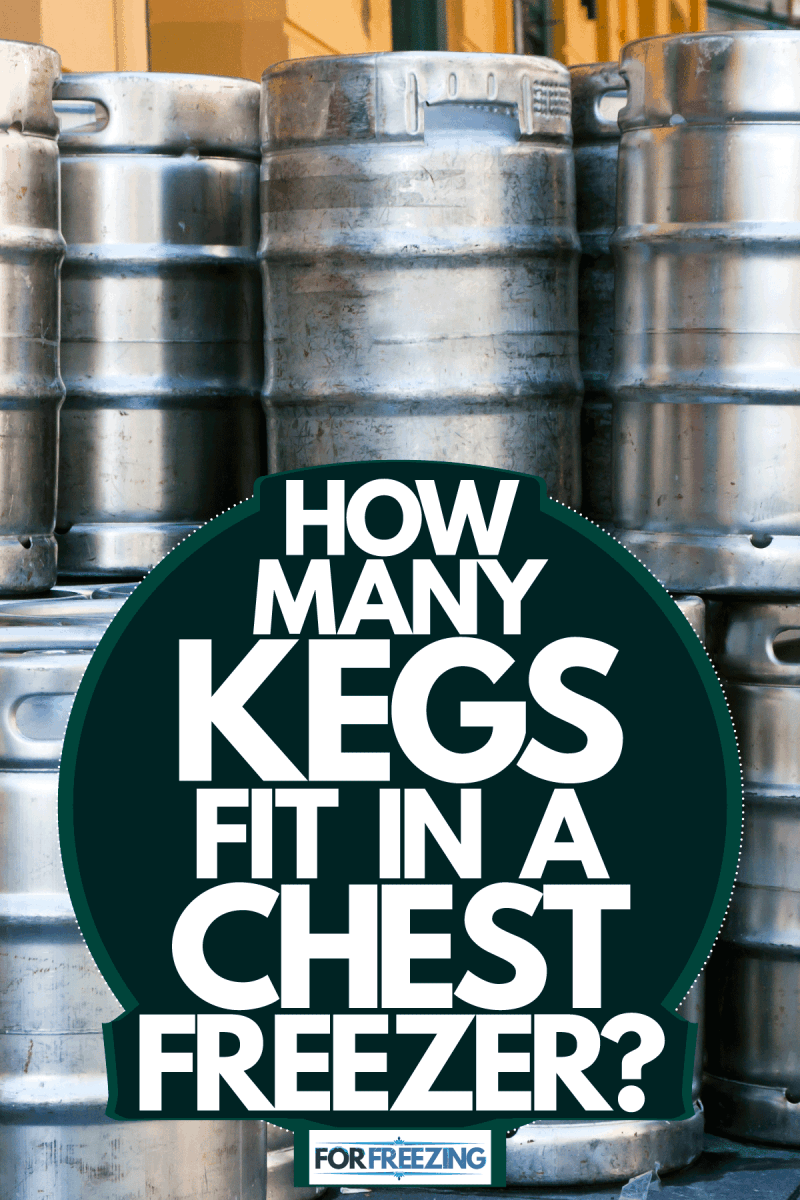In storing your beer at home, you're going to need more space than your usual freezer can offer. Although there are different options available for keg storage, picking out the right one will depend on capacity. One popular choice is the chest freezer. But for the standard size, how many kegs can you fit into it? What sets them apart from other options? We looked these up and summarized them here.
You can fit 2 to 4 kegs in total with a standard-sized chest freezer. Homebrewers usually look for a 5 or 7 cubic feet chest freezer because it takes up just enough room in a home. Kegs also come in different sizes, so it would help if you measure and visualize everything before picking out a freezer.
A few more things to consider as a homebrewer include the type of freezer to use, how to convert a chest freezer for kegs, and temperature regulation to ensure proper storage. Keep reading for further insight on these topics.
NOTE: WE MAY GET A COMMISSION IF YOU DECIDE TO MAKE A PURCHASE THROUGH THESE LINKS. THERE'S ADDITIONAL NO COST TO YOU. CHECK THE BOTTOM OF THE PAGE FOR MORE INFORMATION.

What Is A Keezer?
A Keezer is a type of storage that allows you to have multiple beers on tap. This commonly starts with a chest freezer that is converted into a refrigerator by controlling temperatures. For homebrewers, a Keezer is a simple solution to storing more beer kegs at a lower cost.
The size of the chest freezer you will be using determines how many kegs you can store. Some come in varying sizes, so taking measurements is one way to identify the number of barrels you can keep. A standard corny keg measures approximately 9 x 23 inches. In a 7 cubic feet chest freezer, 3 to 4 of these will likely fit.
Note that you have to make room for your CO2 tank in the freezer when measuring. You will need a CO2 tank in a Keezer, mainly to dispense the beer.
How Does A Keezer Work?
Converting a chest freezer into a Keezer requires you to remove the freezer's ability to freeze. Doing so would involve the use of a thermostat to control the inside temperature. The thermostat, or temperature controller, shuts the freezer off when it reaches a specific temperature to keep the beer from freezing.
What Parts Do I Need For A Keezer?
You can build a Keezer yourself with the following parts:
- Beer kegs
- Tap handles (same amount of kegs inside)
- Chest freezer
- Liquid lines (for each keg)
- CO2 tank
- CO2 regulator
- CO2 manifold
- Temperature controller
The chest freezer is the main factor in determining how many of each part you would need. The number of beer kegs that would fit in the freezer varies on the chest freezer's capacity. For instance, you can store 3 kegs and a larger CO2 tank in a 7 cubic feet chest freezer. It means you would have to buy 3 tap handles and liquid lines.
Conversion kits are available, providing you with all the tools you need for converting a chest freezer to a dispenser. These usually come with the materials for building a Kegerator. So when making a Keezer, it may require you to purchase additional tools not included in the kit.
How to Build A Keezer
Making a DIY Keezer may take time, but the instructions are easy to follow. This video below explains what you should do:
Below is a summary of the steps you need to take in building a Keezer:
- Choose a chest freezer that can hold your chosen keg size.
- Build the freezer's collar. It is where the tap handles and lines will connect.
- Unscrew the lid of the chest freezer to make space for the collar.
- Mark and drill where the handles will go, then attach it to your freezer with a sealant. Be sure your collar fits properly before gluing it down.
- Reattach the freezer's lid once the collar is sealed well.
- Install the liquid lines for each keg.
- Prepare and install the CO2 regulator, distributor, and manifold for the gas line.
- Add a CO2 tank that's good for the number of kegs you will store.
- Install and set the temperature controller to the chest freezer.
- Store the beer kegs in the Keezer once completed.
What Is The Difference Between A Kegerator And A Keezer?
Two popular beer storage options are the Kegerator and Keezer. While both of these choices are ideal for homebrewing, they each have pros, cons, and varying features.
A Kegerator is a modified refrigerator specifically made for storing and dispensing beer. They can hold beer quality for an average of two months. It can last for up to six months when stored under the proper temperatures. For homebrewers who are looking to keep a single keg, this is a recommended choice.
A Keezer functions the same way a Kegerator does but is built from a freezer instead of a refrigerator, commonly with chest freezers. It is better for storing more kegs at once because of the space available. As opposed to a Kegerator, it requires more effort to make if you're looking to build it yourself. Otherwise, a Keezer works well for longer and larger storage.
What Temperature Should I Set My Keezer At?
The ideal temperature to set a Keezer at is 38 degrees Fahrenheit. Anywhere between 36 to 40 degrees Fahrenheit works well in keeping the beer cool enough while maintaining the flavor and carbonation. Setting the temperature at a level too hot or cold affects the taste and quality of the beer, so it would be best to prevent it from happening.
Temperature is vital in ensuring your beer retains freshness in storage. Some of the reasons why you should consider temperature includes:
Proper Carbonation
The temperature should be at a level that makes it possible for carbon dioxide to be soluble to maintain carbonation in drinks. The process involves the dissolving of gas into a liquid. The pressure from this must become equal to the pressure that pushes down the liquid. Lower temperatures would be required to achieve this process.
Longer Shelf Life
Refrigeration lengthens the shelf life of beer, especially when the temperatures are just right. When stored under proper conditions, a keg lasts up to 2 months and longer when it's pasteurized. Ideally, it lasts up to 6 months before it starts to spoil.
Consistent Taste
Changes in taste occur when you place them under incorrect temperatures. They may have too much carbonation or change in terms of texture. Freezing beer won't be harmful as long as it doesn't stay frozen for over 30 minutes.
Raising the temperature too high can cause CO2 to break out of the beer, resulting in foamy and sour drinks. Bacteria growth can also occur at temperatures beyond 50 degrees Fahrenheit.
How Do I Control My Keezer Temperature?
You can control a Keezer's temperature by installing a temperature controller or thermostat. Chest freezers initially freeze the beverage items placed inside. You will have to make adjustments when converting it into a Keezer to keep it from freezing the beer.
Some of the things you should consider when choosing a temperature controller are the following:
- The presence of a compressor delay protection
- Efficiency and ease of use when plugging to power
- Temperature indication in both Celsius and Fahrenheit measurements
To Summarize
A chest freezer is recommended for beer storage because you can use it for dispensing the beer. The number of kegs you can fit into it varies on the size of the freezer. Homebrewers often look for a standard-sized chest freezer of 5 to 7 cubic feet. If you're using typical corny kegs, 2 to 4 beer kegs will fit into the freezer.
A Keezer is best for larger storage capacity and dispensing, as opposed to Kegerators. You can build them on your own with the right parts. Note that, when making your own Keezer, the temperature plays a vital role in maintaining the beer's shelf life and overall quality.



